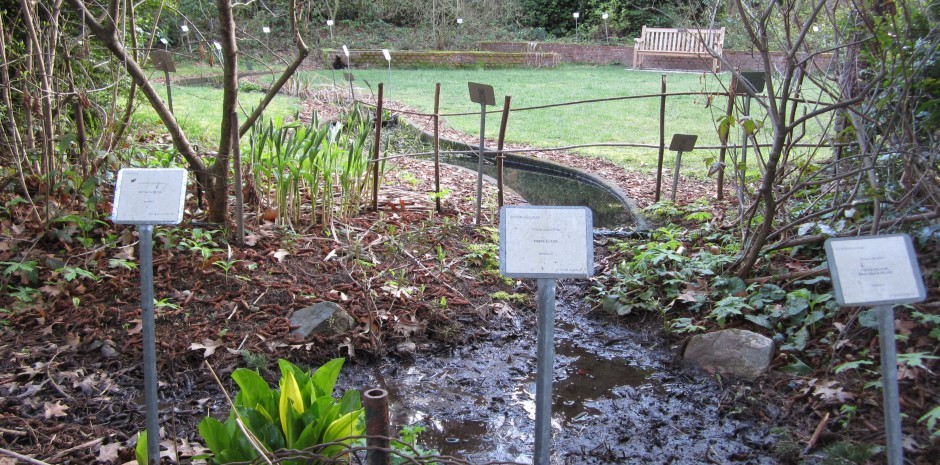I first encountered a xeriscape garden in 1990, while living in Austin, Texas. Xeriscaping is gardening with plants that require very little or no watering. It certainly made sense in a hot, dry (though humid in summer, ack!) place like central Texas. It also makes sense in Seattle. We have a Mediterranean climate, with cool, rainy winters and warm, dry summers.
In Seattle, we are billed at a higher rate for our water in summer because there is more demand and the resource is limited. But summer is when many plants need supplemental water to survive. Luckily, there are plants from the drylands of the world which do very well without summer water. The biggest limitation, for some but not all, is the sodden ground of winter. Without extremely good drainage, many plants from the drylands will rot in winter.
In the Medicinal Herb Garden xeriscape bed, I use a mixture of pumice and gravel, heaping it up above the level of the surrounding ground to ensure good drainage.
Many species of Opuntia are valuable food crops around the world, but they have also been used for medicine. Opuntias are New World plants and so, almost without exception, are all cacti, which grow from Canada to the southern tip of South America. There is, however, one exception, Rhipsalis baccifera which grows in tropical America, tropical Africa and islands east to Sri Lanka. Mystery. As the theory goes, they have probably floated to the Old World in debris after large storms.
But, back to Opuntias. They’re called nopal in Latin America. Nopal is a Native American word, from the Nahuatl language of the Nahua people of Central Mexico. The nopal pads are eaten in a variety of ways in Mexican cuisine. You should grow some in your yard, in your xeriscape.
And then there’s the fruit, the prickly pear or tuna. Though they are from the New World, Opuntias have been embraced by the Old World. They grow all around the Mediterranean. I’ll borrow this line from The Story of Foods by Forrest Crissey, “In Mexico and Sicily, the poor people look upon the prickly pear with great respect, as it forms an important part of their food supply and is used in many different ways – as fruit, as salad and as jelly.” I was in high school when my mother first brought home a prickly pear. She said it had been her father’s favorite fruit. He and my grandmother emigrated to the US from Sicily and wherever there were Sicilians on the east coast, you could find prickly pears at the markets. I’d seen them at produce stands, but had never bothered to try one. I have to admit to being underwhelmed at my first taste. I’d take a mango or a passion fruit over a prickly pear any day. But prickly pears can grow where most other plants wither and blow away. That’s their magic and we might get to appreciate this virtue soon enough, as hotter and drier summers become the norm here.
If you’re in Seattle and want to see a very successful garden of Opuntias, some with fruit still attached, go to the west side of El Centro De La Raza on Beacon Hill, just before the corner of Bayview and 16th Ave S, and behold (update: to make room for a new parking garage, the Opuntia garden has been displaced. Hopefully they will reappear somewhere else on the grounds). Unfortunately, we can’t grow the Opuntia ficus-indica outside in Seattle (at least in winter). That is the species which normally produces the prickly pears of commerce. Fruit are smaller on the species that can survive winters here.

Opuntia humifusa (prickly pear) Believe it or not, they grow from Montana to New Mexico, east to Ontario and Florida.

Opuntia imbricata (tree cholla) These are laughably sad little specimens, but they’ve tenaciously endured many winters in the garden.
Balsamroot seeds, roots, young shoots, leaves, petioles and flowers are edible and the seeds are rich in oil. We associate them with the east side, but so far, I’m having luck with them in the Medicinal Herb Garden. If you have a well-drained, sunny spot, get some seeds (they need cold stratification to germinate) and start growing them. People cross the Cascades to see the balsamroot blooming in springtime. Think of the gas you can save by growing them yourself.

Ceanothus cordulatus (snowbush) with unopened flowers. Keep it dry and it will stay small(ish). I’ve cut it back hard, to make room in the xeriscape bed, and the new growth looks quite natural.
If you have a dry, sunny slope in your yard where you’re growing juniper or rock rose, you might consider adding some more diverse, edible and medicinal plants to your xeriscape (yes, you already have one, good work!) that will be the envy of your neighbors.
hot sun and dry land
deep blue mirage, not water
on the horizon
See you in the garden








Hello – can you suggest a place to get small pumice for mixing into potting soils that isn’t in those small, crazy expensive bags? It’s hard to find. thanks, r
Hi Rachel,
For bulk you might try T. E. Walrath in Tacoma and for large bags, you might try the Indoor Sun Shoppe in Seattle.
Good luck,
Keith
Thank you! So appreciate it. I didn’t know there was a UW herb garden – must come visit!